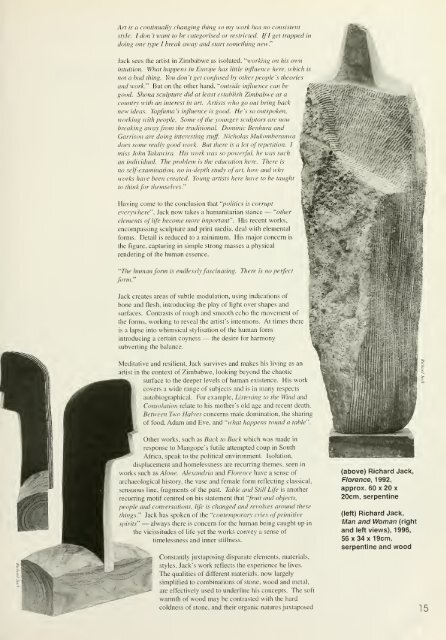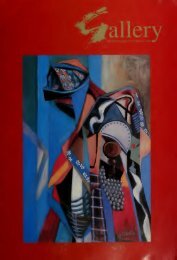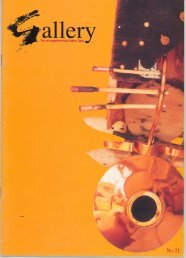Gallery : the art magazine from Gallery Delta
Gallery : the art magazine from Gallery Delta
Gallery : the art magazine from Gallery Delta
Create successful ePaper yourself
Turn your PDF publications into a flip-book with our unique Google optimized e-Paper software.
Arl is a continually changing thing so my work has no consistent<br />
style. I don 't want to be categorised or restricted. If I get trapped in<br />
doing one type I break away and st<strong>art</strong> something new"<br />
Jack sees <strong>the</strong> <strong>art</strong>ist in Zimbabwe as isolated, "working on his own<br />
intuition. What happens in Europe has little influence here, which is<br />
not a bad thing. You don 't get confused by o<strong>the</strong>r people 's <strong>the</strong>ories<br />
and work." But on <strong>the</strong> o<strong>the</strong>r hand, "outside influence can be<br />
good. Shona sculpture did at least establish Zimbabwe as a<br />
country with an interest in <strong>art</strong>. Artists who go out bring back<br />
new ideas. Tapfuma 's influence is good. He 's so outspoken,<br />
working with people. Some of <strong>the</strong> younger sculptors are now<br />
breaking away <strong>from</strong> <strong>the</strong> traditional. Dominic Benhura and<br />
Garrison are doing interesting stuff. Nicholas Mukomberanwa<br />
does some really good work. But <strong>the</strong>re is a lot of repetition. I<br />
miss John Takawira. His work was so powerful, he was such<br />
an individual. The problem is <strong>the</strong> education here. There is<br />
no self-e.xamination. no in-depth study of <strong>art</strong>. how and why<br />
works have been created. Young <strong>art</strong>ists here have to be taught<br />
to think for <strong>the</strong>mselves."<br />
Having come to <strong>the</strong> conclusion that "politics is corrupt<br />
everywhere" , Jack now takes a humanitarian stance — "o<strong>the</strong>r<br />
elements of life become more important" .<br />
His recent works,<br />
encompassing sculpture and print media, deal with elemental<br />
forms. Detail is reduced to a minimum. His major concern is<br />
<strong>the</strong> figure, capturing in simple strong masses a physical<br />
rendering of <strong>the</strong> human essence,<br />
"The human fonn is endlessly fascinating. There is no perfect<br />
form."<br />
Jack creates areas of subtle modulation, using indications of<br />
bone and flesh, introducing <strong>the</strong> play of light over shapes and<br />
surfaces. Contrasts of rough and smooth echo <strong>the</strong> movement of<br />
<strong>the</strong> forms, working to reveal <strong>the</strong> <strong>art</strong>ist's intentions. At times <strong>the</strong>re<br />
is a lapse into whimsical stylisation of <strong>the</strong> human form<br />
introducing a certain coyness — <strong>the</strong> desire for harmony<br />
subverting <strong>the</strong> balance.<br />
Meditative and resilient. Jack survives and makes his living as an<br />
<strong>art</strong>ist in <strong>the</strong> context of Zimbabwe, looking beyond <strong>the</strong> chaotic<br />
surface to <strong>the</strong> deeper levels of human existence. His work<br />
covers a wide range of subjects and is in many respects<br />
autobiographical. For example. Listening to <strong>the</strong> Wind and<br />
Consolation relate to his mo<strong>the</strong>r's old age and recent death.<br />
Between Two Halves concerns male domination, <strong>the</strong> sharing<br />
of food, Adam and Eve, and "what happens round a table".<br />
O<strong>the</strong>r works, such as Back to Back which was made in<br />
response to Mangope's futile attempted coup in South<br />
Africa, speak to <strong>the</strong> political environment. Isolation,<br />
displacement and homelessness are recurring <strong>the</strong>mes, seen in<br />
works such as Alone. Alexandria and Florence have a sense of<br />
archaeological history, <strong>the</strong> vase and female form reflecting classical,<br />
sensuous line, fragments of <strong>the</strong> past. Table and Still Life is ano<strong>the</strong>r<br />
recurring motif centred on his statement that "fruit and objects,<br />
people and conversations, life is changed and revolves around <strong>the</strong>se<br />
things." Jack has spoken of <strong>the</strong> "contemporary cries ofprimitive<br />
.spirits" — always <strong>the</strong>re is concern for <strong>the</strong> human being caught up in<br />
<strong>the</strong> vicissitudes of life yet <strong>the</strong> works convey a sense of<br />
timelessness and inner stillness.<br />
Constantly juxtaposing disparate elements, materials,<br />
styles. Jack's work reflects <strong>the</strong> experience he lives.<br />
The qualities of different materials, now largely<br />
simplified to combinations of stone, wood and metal,<br />
are effectively used to underline his concepts. The soft<br />
warmth of wood may be contrasted with <strong>the</strong> hard<br />
coldness of stone, and <strong>the</strong>ir organic natures juxtaposed<br />
./ifC'~<br />
(above) Richard Jack,<br />
Florence, 1992,<br />
approx. 60 X 20 X<br />
20cm, serpentine<br />
(left) Richard Jacl







